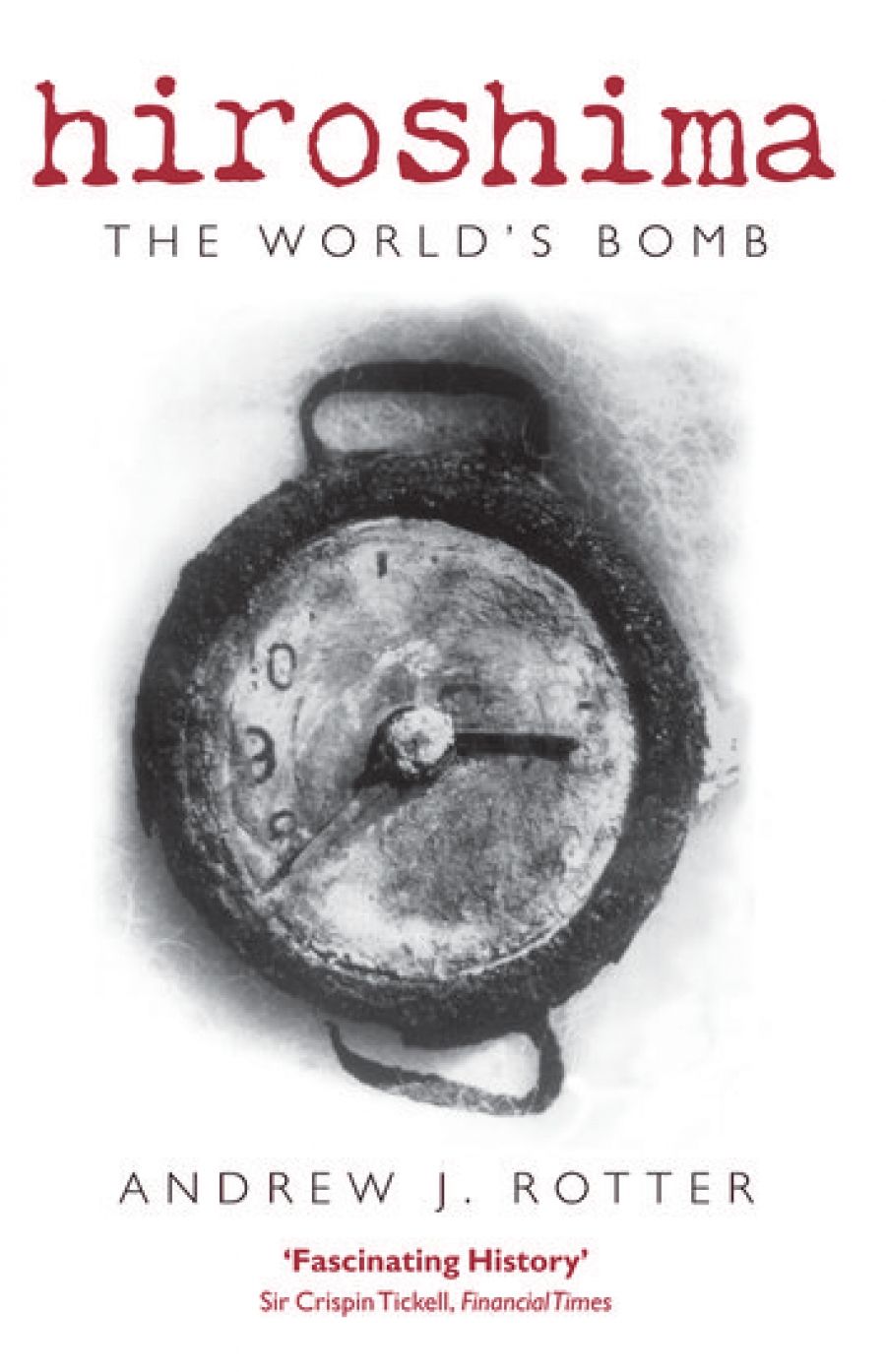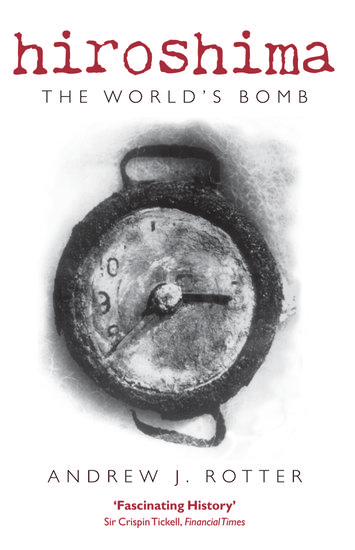
- Free Article: No
- Custom Article Title: Everybody’s offspring
- Review Article: Yes
- Article Title: Everybody’s offspring
- Online Only: No
- Custom Highlight Text:
Andrew Rotter does not usually write about nuclear weapons. The Colgate University Charles A. Dana Professor of History is known for his works on twentieth-century American diplomatic history. He was approached, ‘out of the blue’, by David Reynolds in the summer of 2001, just before the attack on the Twin Towers. Reynolds, well known for his writings on the so-called ‘special relationship’ between the two English-speaking powers on either side of the Atlantic, was advising Oxford University Press on its series of the significant events of the twentieth century. Few events were more significant than the use of a nuclear weapon on Hiroshima in August 1945.
- Book 1 Title: Hiroshima
- Book 1 Subtitle: The world’s bomb
- Book 1 Biblio: Oxford University Press, $65 hb, 379 pp
- Book 1 Cover Small (400 x 600):

- Book 1 Cover (800 x 1200):

The decision to drop the bomb, writes Rotter, should not be seen in isolation. He does not blame President Harry Truman or even the American military and scientific establishment for the use of such weapons against urban targets in which many innocent civilians were killed and maimed. It might have been an American mission but the despatch of the B-29 bomber to Hiroshima came after the development of a vast multinational effort in the development of nuclear weapons. The bomb was ‘everybody’s offspring’, writes Rotter, and the destruction of Hiroshima was ‘an episode in international history’. The book provides a detailed reminder of the pioneering work undertaken in Britain in the 1930s by a group of international scientists who had found both safe haven from Nazi oppression and a government willing to lend support to their work. When that work had developed to the extent of forming a top secret committee called MAUD to advise on the practicality of fabricating such a weapon, the decision was taken to enlist the United States as a partner. A central figure here was the Australian physicist Mark Oliphant, who was dispatched to convince the Americans of the project’s feasibility. The resultant Manhattan Project was indeed put under American command, but it was an international effort.
So was the military doctrine that governed the use of the bomb. Rotter reminds his readers that the use of weapons of mass destruction started in the previous world war. Chemical weapons had been used by both sides on the Western Front, and then by the British against the Bolsheviks in 1919, and against the rebellious tribes in Iraq in the 1920s. The Italians followed suit in Abyssinia in the 1930s. Nuclear weapons then were but a step in the application of science to war.
So too was the development of air power. Rotter argues that the Americans were reluctant latecomers to the strategy of mass-targeting civilians. European strategic thinkers such as Giulio Douhet and J.F.C. Fuller had championed the use of air power since the 1920s. The Italian writer Bernedotto Croce had written that governments would find no use for morality in pursuing the national interest on the battlefield, and the English-man Hugh Trenchard had fashioned a doctrine of using air power to destroy urban targets. As early as 1940, Winston Churchill had ordered strikes on Berlin, the forerunner to the mass bombing of civilians in Hamburg and Dresden. Hiroshima was a stage, albeit a bloody one, in the use of air power.
While Rotter concentrates his work on the Allied effort, he argues that others pursued the development of nuclear weapons. The Germans had the scientists and the will to use the bomb. What they lacked was the centralised organisation and commitment to the bomb as an immediate prospect in the current conflict. Japan, too, dabbled in the development of laboratory-level work, but did not realise the immediate potential of the weapon. The Russians did. It wasn’t their infamous ‘atomic spies’ alerting them to the Manhattan Program that explained their success but rather that they had been working in the field since the 1930s and had many of the facilities and raw materials to follow in the Allied footsteps.
Rotter traces the familiar story of America’s attempts to monopolise the bomb after the war. It was a futile effort. Nevertheless, Truman moved to develop the atomic bomb as a key part of the American arsenal. Pointedly, the United Nations would not be given a meaningful role in the new science. The American delegate to the United Nations, Bernard Baruch, would talk of a futuristic sharing of atomic energy for civil use – an exercise that Rotter characterises as ‘Baruch’s grotesque charade’. Within a relatively short time, however, the Soviet Union, Britain, France and China had all fashioned nuclear arsenals. States would pursue the bomb, Rotter opines, because of the need for security, scientific curiosity, status and ‘bureaucratic momentum’. The line is then drawn to the post Cold War world, with its suitcase-sized devices, rogue nuclear states and stateless terrorist groups which threaten mass destruction of innocent life. It is all part of the evolution of the bomb since Hiroshima.
Despite this bleak but timely assessment of nuclear weapons since Hiroshima, Rotter’s work is a synthesis. There is nothing that is new here for readers in this field. Margaret Gowing long ago chronicled the multinational effort in Britain. Richard Rhodes’s award-winning works have dealt in more detail with the development of the American fission and fusion bombs. Gregg Herken’s The Winning Weapon (1981) detailed the attempt by Truman to conceal the secret of the bomb, while David Holloway’s Stalin and the Bomb (1994) used Soviet archives at the end of the Cold War to piece together the development of an indigenous nuclear programme that pre-dated the contributions of the KGB’s atomic spy ring.
The book is strongest when it sticks to the debate around the bombing of Hiroshima. Readers will find an excellent summary – which closely follows the work of Samuel Walker’s scholarship – of the debate over whether Japanese cities should be targeted using nuclear weapons. Rotter captures the actors well: Truman setting aside the doubts of his advisers and pressing on to develop thermonuclear weapons (‘let’s get on with it’), Secretary of State James Byrnes threatening the Soviet diplomats the month after Hiroshima (‘I’m going to pull an atomic weapon out of my pocket and let you have it’), and the Manhattan Program’s director, the secretive General Leslie Groves, admonishing his incredulous audience at the moment of the first nuclear Trinity atomic test in New Mexico that they must ‘keep this quiet’. The 20,000 TNT test was heard in five states.
Rotter fails, however, to provide a convincing critique of the developments after Hiroshima. Here Rotter overreaches himself. His sources are far too limited and the field is vast. He is selective in his narration of nuclear proliferation, with a brief account of the developments in Britain, France, China, India, Israel and South Africa. His assessment of the threats posed by Iran and North Korea in the post-Cold War period do little justice to the developing debate about nuclear non-proliferation. With more than twenty-five states with nuclear weapons, some of which can be mobilised in a matter of hours, Rotter’s prognosis that George W. Bush’s gallery of rogue leaders constitute a threat is well short of the mark. The bomb that was dropped on Hiroshima was the result of the war’s biggest single industrial effort. Hiroshima tells us of a global contest among great powers and the potential behaviour of the United States as a sole super-power. And that story is not told on these pages.


Comments powered by CComment